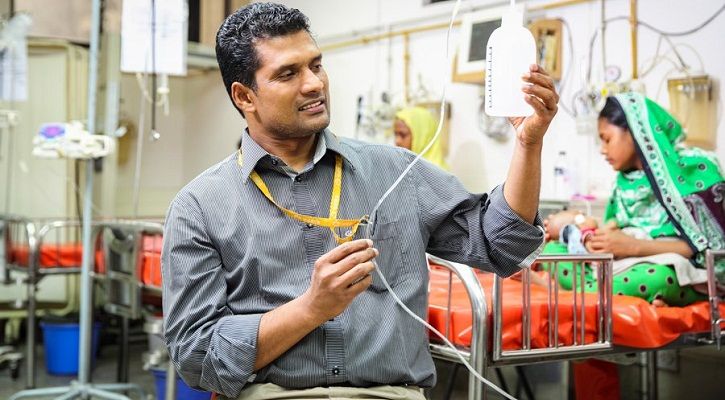This Doctor use Plastic bottles to save babies with Pneumonia
 Pneumonia is one of the leading cause of death among the infants in the world. Last year only, pneumonia claimed the lives of 9,20,000 children under the age of five. It’s the result of a bacterial, viral, or fungal infection in the lungs, which causes pus to build up in the alveoli, the oxygenation agents we rely on. To counter the effects, the body makes the lungs work harder and faster, which causes breathlessness.
Pneumonia is one of the leading cause of death among the infants in the world. Last year only, pneumonia claimed the lives of 9,20,000 children under the age of five. It’s the result of a bacterial, viral, or fungal infection in the lungs, which causes pus to build up in the alveoli, the oxygenation agents we rely on. To counter the effects, the body makes the lungs work harder and faster, which causes breathlessness.
While the richer countries can afford expensive ventilators, poorer countries have to find some other cheaper way. Oxygen was being delivered to them, through a face mask or via tubes placed near their nostrils, using what is called a basic “low-flow” technique which followed World Health Organisation (WHO) guidelines for low-income countries. But when Dr Mohamad Chisti, on his first night as a trainee paediatrician in Sylhet, Bangladesh, saw three children die of pneumonia, all the techniques were failing. That’s how he decided to find a better way to tackle this. The idea came to him on a trip to Australia when he saw a new type of hospital ventilator called ‘bubble-CPAP'(continuous positive airway pressure), used to help premature babies breathe. This device helps the infants’ breath easier. The device channels an infant’s exhalations through a tube with its other end immersed in water. The exhaled breaths bubble up from the liquid, which causes fluctuations in the air pressure of the tube. These rapid pressure changes are fed back to the child’s lungs, which help the alveoli exchange carbon dioxide for oxygen, thus requiring less effort from them and making breathing easier. But even the bubble-CPAP cost about Rs 4.3 lakh, which was too expensive for the hospital where Chisti worked. Thus he found an alternative for the device. He figured out discarded shampoo bottle with bubbles in it. He built his own version of bubble-CPAP using an oxygen supply, plastic bottle filled with water and some tubing. Chisti and his colleagues published the results of their trial with the jury-rigged ventilator in the Dhaka Hospital of the International Centre for Diarrhoeal Disease Research. The results were astonishing and the hospital is now regularly using the device. The number of infant deaths due to pneumonia has also reduced by three quarters. That makes the survival rate of infants there almost equal to the children treated in the richer countries. Dr Chisti also says that the hospital’s spending on pneumonia treatment has also reduced by 90 per cent. Now, they are planning to conduct more trials in Ethiopia and if everything turns out to be well, this little plastic-bottle ventilator could spread to poor hospitals around the world, saving hundreds of thousands of children in the process.
Source: https://www.indiatimes.com/technology/science-and-future/this-doctor-uses-plastic-bottles-instead-of-expensive-ventilators-to-save-babies-with-pneumonia-352650.html
https://www.economist.com/science-and-technology/2018/09/08/how-a-shampoo-bottle-is-saving-young-lives